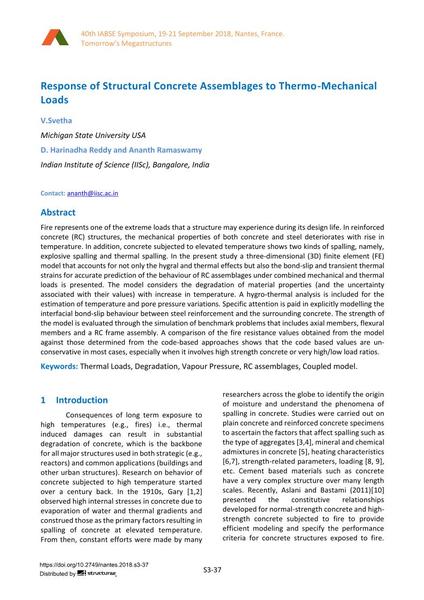Response of Structural Concrete Assemblages to Thermo-Mechanical Loads

|
|
|||||||||||
Bibliographic Details
| Author(s): |
V. Svetha
(Michigan State University USA)
D. Harinadha Reddy (Indian Institute of Science (IISc), Bangalore, India) Ananth Ramaswamy (Indian Institute of Science (IISc), Bangalore, India) |
||||
|---|---|---|---|---|---|
| Medium: | conference paper | ||||
| Language(s): | English | ||||
| Conference: | IABSE Symposium: Tomorrow’s Megastructures, Nantes, France, 19-21 September 2018 | ||||
| Published in: | IABSE Symposium Nantes 2018 | ||||
|
|||||
| Page(s): | S3-37 | ||||
| Total no. of pages: | 8 | ||||
| DOI: | 10.2749/nantes.2018.s3-37 | ||||
| Abstract: |
Fire represents one of the extreme loads that a structure may experience during its design life. In reinforced concrete (RC) structures, the mechanical properties of both concrete and steel deteriorates with rise in temperature. In addition, concrete subjected to elevated temperature shows two kinds of spalling, namely, explosive spalling and thermal spalling. In the present study a three-dimensional (3D) finite element (FE) model that accounts for not only the hygral and thermal effects but also the bond-slip and transient thermal strains for accurate prediction of the behaviour of RC assemblages under combined mechanical and thermal loads is presented. The model considers the degradation of material properties (and the uncertainty associated with their values) with increase in temperature. A hygro-thermal analysis is included for the estimation of temperature and pore pressure variations. Specific attention is paid in explicitly modelling the interfacial bond-slip behaviour between steel reinforcement and the surrounding concrete. The strength of the model is evaluated through the simulation of benchmark problems that includes axial members, flexural members and a RC frame assembly. A comparison of the fire resistance values obtained from the model against those determined from the code-based approaches shows that the code based values are un- conservative in most cases, especially when it involves high strength concrete or very high/low load ratios. |
||||
| Keywords: |
thermal loads degradation Vapour Pressure RC assemblages Coupled model
|
||||
